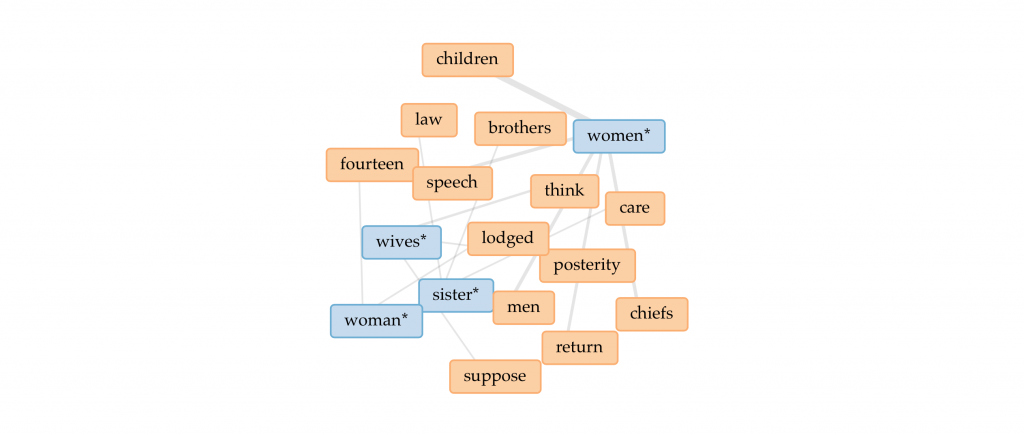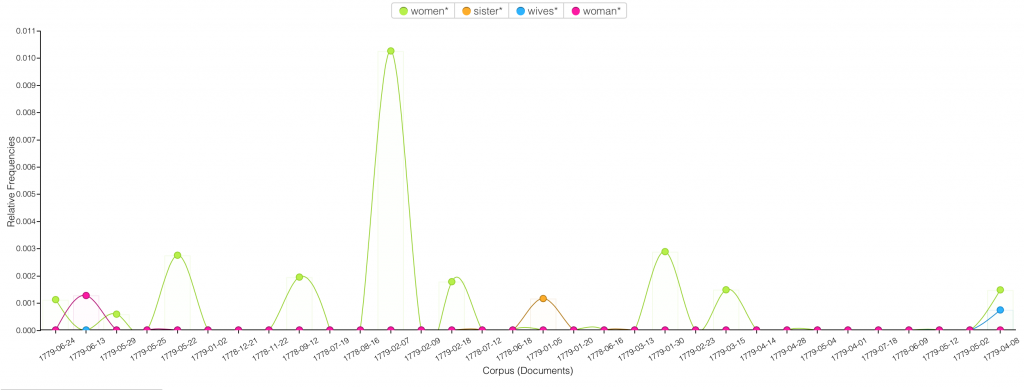This study examines the perspectives of Native American speakers representing a number of different tribes in the Ohio River Valley and Wabash Valley in what is now the American Midwest between 1754 and 1814. Some of these tribes include Potawatomi and Michilimc. As we explored in what ways did their actions shape the course of early American history, we interested in understanding how was gender and women’s roles in the treaty councils and Native communities and if there was any ideas about race and racism expressions in the sources and how these notions changed over time.
In order to explore the issues of gender and race in early history of America, we chose to use several tools in the Voyant Tools suite. Voyant Tools is an open-source, web-based text analysis application. With this application, we could explore our main research questions in more effective way with more details that we might not catch when we just read a text by itself. With the Voyant Tools, it was easy to navigate each different performances for better text analysis such as TermsBerry, Reader, Correlations and Phrases and choose each different performances depending on the topic that we are mostly interested. For example, since we mostly needed to use specific words indicating gender and race issues such as “White” or “Women”, this application was very helpful for exploring how each word was used in different sentence using the “Phrases”, and also figure out trend of the word as well.
Using this Voyant Tool, we found out some aspects of Race and Gender in Native American History. As a racial issue, we found out that there was clear evidence where people tend to be categorized based on their skin color such as “White” and “Brown”. Also, using some terms presenting the female such as “Women”, “Wives”, and “Sister”, we also found out that how masculinity was taking power over the women during the councils as well.
Race

- To find out how racial issues were involved from the councils, I used the Voyant tool for both native speakers file and non-native speakers file observing how some words related to racism was used toward each other.The first sentence I found out was from Native speaker. The full sentence was “I open your eyes that you may see clear & your ears that you may listen to my words, since I speak by order of the great King my master, who is the Father of us all, whether of white or brown skins.” In this sentence, we can assume people were separated and categorized by their skin color either White and Brown.

- Also, native Americans tend to call the Europeans as “White Eyes”. We can surely indicate that the “White Eyes” was pointing the Europeans since following sentence was regarding “Captain James”
- We found out very interesting results from searching for word “White” using the Voyant tool. The word “White” was often used to describe the wampum which is one of our research topic that means a big symbol during the councils. It seems like the Wampum was also presented the different (Native/Non-native) using the different color of strings (White and Black) where mixture of the color can mean peace, harmony or equality. (ex. 8 white and 8 black strings)

- Also, the word links show that there are clearly having connection between White and Black with strings. In the document of Native Speaker, we can notice that they keep repeating records of number of white and black wampum and belts. However, surprisingly, from the non-native speaker file, there were not many words related to the race other than how people described the native Americans as “Brown Skins” and explains about them as slave man who need to keep working to preserve their own rights.
Gender
In the documents provided, women are unfortunately rarely mentioned. In comparison to other words in the corpus, the terms women*, wives*, sister*, and woman* are used only 22, 1, 1, and 1 times, while terms like brother* are used 320 times. In the corpus, the only reference to woman is in relation to men or masculine identifying tribes taking care of them. An instance of this is the phrase “I shall hereafter take care of my sister in law”. This corresponds with the findings in “Indian Policy and the Imagined Indian Woman” by Bethany R. Berger, and affirms the idea that women were not typically involved in or a part of treaty councils, which was a research question we initially had.



